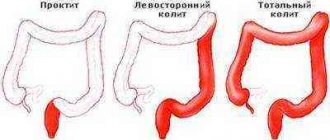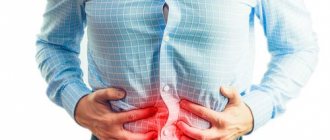Causes of the condition
If you feel a little nauseous in the morning or throughout the day, there is mild pain in the stomach, slight weakness and heartburn, the cause of the malaise is the following conditions:
- Pregnancy. Most often, a woman vomits in the first trimester. If this condition lasts longer than 3 months, you should seek medical help.
- Ectopic pregnancy. In this case, sharp abdominal pain and nausea occur from the first week of conception. Ignoring symptoms that gradually worsen can be fatal.
- Eating spicy or fatty foods, as well as alcohol. Unpleasant symptoms most often occur 1-2 hours after consuming them. Alcohol poisoning is often accompanied by headaches and fever.
- Nervous overstrain. If a person is in a stressful situation, hormones are released, which causes nausea and pain.
Abdominal pain complicated by vomiting in adults
In adults, in addition to banal food poisoning, abdominal pain and vomiting at the same time can accompany a variety of diseases: intestinal obstruction, gastric and duodenal ulcers, cholecystitis, inguinal hernia, hepatitis, inflammation of the pancreas (acute pancreatitis). Doctors note that these symptoms often appear in diseases of the genitourinary system, tuberculosis, Meckel's diverticulum, Crohn's disease, and helminthic infestations.
Severe pain with the urge to vomit are characteristic signs of acute inflammation of the appendix of the cecum - appendicitis. With this pathology, the delay in death is similar. Failure to provide a sick person with timely assistance can lead to purulent damage to the entire abdominal cavity - peritonitis.
Unfortunately, the causes of abdominal pain complicated by vomiting do not end with the diseases listed above. These symptoms can provoke poisoning with iron, lead, mercury, and medications. It is quite possible that they may appear due to respiratory tract infections or an allergic reaction of the body to any food products, for example, milk. Pain in the stomach, a sharp drop in blood pressure, and vomiting are observed with the gastralgic form of a heart attack. This is a very insidious disease, in which changes in the functioning of the heart on the electrocardiogram often appear only several hours after the attack.
Possible diseases
If your stomach hurts and you feel more and more nauseous every day, the cause of this may be various gastrointestinal diseases.
Peptic ulcer
With this disease, nausea most often begins if a person has eaten something, since food is an irritating factor. Pain and increased salivation also occur. The mucous membranes of the stomach walls have nerve endings, which, during the inflammatory process, begin to send signals to the brain with the requirement to cleanse the organ of food that interferes with the healing of ulcers.
The pain can be sharp and dull. Most often in the morning it is accompanied by nausea and vomiting. Sometimes the vomit may contain blood, indicating gastric bleeding.
Pancreatitis
This is a disease caused by inflammatory and necrotic processes occurring in the tissues of the pancreas. The main symptoms of this pathology are constant nausea, vomiting, flatulence, girdle pain, diarrhea or constipation, changes in blood pressure, and increased temperature. Moreover, the amount of vomit can reach 4-6 liters, which contains particles of undigested food. In some cases, a person begins to vomit “coffee grounds.” This indicates bleeding from damaged pancreatic vessels.
Polyps
These are benign formations that appear on the gastric mucosa. Symptoms of this pathology appear only when the polyps reach large sizes. In this case, cramping pain in the stomach occurs most often after eating food, which irritates the formation located on the mucous membrane. After some time, heartburn, increased gas formation, diarrhea, and vomiting occur.
Appendicitis
This is an acute inflammatory process that occurs in the appendage of the cecum. With this pathology, the stomach begins to hurt sharply, the temperature rises to 39°C, pain appears in the abdomen in the lower right part, which quickly intensifies. The patient complains of pain in the stomach area and to the right of the navel.
Stomach cancer
This is the most dangerous disease. There are 4 stages of the disease, each of which has its own symptoms. The first stage is characterized by increased fatigue and aversion to meat. Anemia develops and the person quickly loses weight. Then pain in the stomach and nausea appear. In the third stage, intestinal obstruction and belching occurs, which has the smell of rotten eggs. The pain syndrome at the last stage is so severe that only narcotic painkillers can help reduce it.
Gastritis
This disease is characterized by aching pain that appears in the stomach area. After eating fatty and spicy foods, nausea, vomiting, and a feeling of heaviness occur. Heartburn, belching, and an unpleasant taste in the mouth occur. The patient has difficulty defecating. Constipation alternates with diarrhea.
Causes
The causes of the above symptoms may be serious illnesses. To understand, it is worth dividing the causes into signs of the disease and physiological manifestations of the conditions. The first includes a disease with symptoms. The root cause should be dealt with immediately if we are talking about signs in a child. The second includes a condition that occurs periodically due to heaviness, bloating after eating, poisoning, when the stomach does not work or digest due to improper nutrition.
Signs of the disease:
- Elevated temperature with nausea, sharp pain in the lower abdomen on the right indicates the presence of appendicitis.
- An aching, nagging pain in the stomach in the morning, an unpleasant odor coming from the mouth along with heartburn, nausea - signs of gastritis.
- Gastroenteritis manifests itself through elevated body temperature, diarrhea, and malaise. The patient feels sick, his stomach constantly turns, and his skin turns pale.
- With cholelithiasis, a feeling of bitterness in the mouth is noted, the stomach is hot, and the patient feels nauseous.
- Growths in the form of polyps and erosions are manifested by abdominal cramps and diarrhea.
- Nausea with dizziness, headache with discomfort in the stomach are manifestations of diseases of the cardiovascular system.
- A tumor is a malignant growth, manifested by severe pain accompanied by nausea.
- Problems with the liver are manifested by malaise and bitterness in the mouth. It bakes on the right below the ribs.
- Nausea in the morning, unpleasant pain localized in the upper abdomen of the patient are signs of a duodenal ulcer.
- Pancreatitis is expressed by pain similar to contractions. The patient suffers from constipation, nausea, and vomiting. Dry mouth is common.
- Intestinal, stomach flu or rotavirus disease is a serious illness that affects people of all ages, children more often. They suffer from nausea, vomiting, pain in the abdomen, malaise with fever, and chills.
Physiological features:
- The stomach often hurts due to poisoning. Weakness, headache, chills with nausea, vomiting and in tandem with diarrhea are signs of food poisoning. Dizziness is often noted, the stomach is full, the body is on fire.
- Nausea and vomiting are pregnancy companions. They are signs of ongoing changes in the body. The symptom of nagging pain in the lower abdomen is the only cause for concern.
- During menstruation, women suffer from pain in the lumbar region, lower abdomen. Nausea and dizziness are additional common symptoms.
- An allergic reaction is manifested by pain in the stomach area, rash, nausea with vomiting.
If you feel sick in the morning
There are many causes of morning sickness. The most common ones include the following:
- Esophagitis is an inflammatory process occurring in the esophagus. Nausea occurs before eating and can occur after a person has eaten. In addition, there is a sensation of a lump in the throat and behind the sternum.
- Gastritis is inflammation of the gastric mucosa. Often, nausea and pain appear in the morning, especially after eating fatty, smoked and spicy foods.
- Inflammation of the duodenum. The pain goes away when the person eats.
- Pancreatitis. In the morning, the patient experiences severe nausea and profuse vomiting, and excruciating sharp pain occurs in the upper abdomen.
- Cholecystitis. This disease causes morning sickness and vomiting of bile.
- Hypertensive crisis. In this condition, nausea and vomiting may occur in the morning. If you do not seek medical help promptly, a heart attack or stroke may develop.
Classification
The nature of the pain syndrome will help the clinician learn more about what disease may have caused the appearance of such symptoms. Thus, stomach pain is divided into:
- aching;
- cutting;
- dagger;
- bursting;
- sharp;
- cramping;
- pulling
- stupid.
Pain in the epigastrium and nausea can be expressed constantly or periodically.
In addition, during diagnosis, the doctor pays attention to the time of onset of symptoms. Nausea and pain occur:
- on an empty stomach;
- directly while eating food;
- some time after the meal. After eating, it can take from fifteen minutes to several hours for such signs to appear;
- at night, which significantly reduces the quality of sleep.
When to sound the alarm
Mild pain that goes away on its own should not cause concern. However, pressing, sharp, aching pain in the stomach, nausea and vomiting often indicate dangerous diseases. You should immediately consult a doctor if the following conditions occur:
- frequent dizziness;
- dark stool and its viscous consistency;
- high fever that lasts more than two days;
- pain in the scrotum in men;
- bleeding in women;
- severe and excruciating pain leading to loss of consciousness;
- blood in the vomit, blood in the stool;
- difficulty with bowel movements;
- the body “burns” due to high temperature;
- urinary retention;
- pale skin;
- nagging pain in the lower abdomen in pregnant women;
- pain syndrome that lasts longer than 5 days.
Abdominal pain complicated by vomiting during pregnancy
Pain in the abdomen and lower back, nausea, and vomiting are well known to any pregnant woman. As a rule, pain is associated with the natural restructuring of the female body to bear a child, implantation of a fertilized egg, changes in hormonal levels, an increase in the size of the uterus, etc. And nausea and vomiting in the first half of pregnancy are signs of toxicosis. This is a complex of pathological changes in the body of the expectant mother, which are also accompanied by a decrease in blood pressure, tachycardia, peripheral circulatory disorders, and neurological disorders. Toxicosis is most pronounced in those pregnant women who previously suffered from diseases of the pancreas and gall bladder.
Stomach pain and vomiting are two symptoms that cannot be ignored. The most correct thing is to consult your doctor. A frivolous attitude towards your health can end badly, because the human body is a delicate mechanism. Take care of yourself!
If a person has pain under the left rib, there is a gag reflex and nausea, then this is a warning sent to the nerve endings about the formation of severe inflammation, for example caused by poisoning. At the same time, the presence of a gag reflex signals that the human body is trying to independently eliminate all toxins that have entered it. The most common cause of pain in the left hypochondrium is stomach diseases, but they can also indicate problems with the pancreas, spleen, large and small intestines, genitourinary tract, heart, blood vessels, intercostal nerves and muscles. We examined possible pathologies and their manifestations in detail in the article “Anterior pain in the left hypochondrium,” but in this publication we will focus on diseases in which there is pain in the stomach and nausea with vomiting.
Diagnostics
The doctor prescribes treatment after carrying out the necessary diagnostic measures. First of all, he interviews the patient, which allows him to find out the reason that caused such disturbances in the body. The specialist is interested in the location of the pain, its frequency, and what food the patient ate the day before. After this, the doctor begins an examination, assessing the condition and size of the internal organs using palpation. Some signs help determine the type of disease.
To make an accurate diagnosis, the patient must undergo the following examinations:
- analysis of stool, urine and blood;
- Abdominal ultrasound, which shows how various organs function and their condition;
- fibrogastroduodenoscopy - in this case, the upper part of the esophagus, stomach and duodenum is examined to detect the pathological process;
- gastroscopy – using an adapted probe, the inner surface of the stomach is examined.
Stomach diseases
Of course, it is not surprising that if your stomach hurts, it is due to its illness. Let's look at the most common diagnoses that doctors make when this organ is damaged.
Gastritis
Occurs when the gastric mucosa becomes inflamed as a result of long-term use of medications, frequent consumption of alcoholic and carbonated drinks, and an unbalanced diet. Many doctors believe that the main cause of gastritis is the appearance of the bacterium Helicobacter pylori in the stomach.
The disease manifests itself with aching and dull pain. The stomach hurts especially badly after eating overcooked, oversalted food with the addition of a large amount of spices.
In addition, patients may experience:
feeling of heaviness, bloating, heartburn, belching, gag reflex, flatulence, diarrhea or constipation.
If these symptoms begin to appear regularly and at the same time intensify, then you need to consult a specialist.
To diagnose the disease, fibrogastroduodenoscopy is performed. Treatment includes both taking medications, which, depending on the form and causes of gastritis, can have enveloping, analgesic, adsorbent, detoxifying, antiseptic, antihistamine effects, and diet.
At home, to help yourself during an attack of gastritis, you need to drink a quarter glass of warm, but not hot, water every ten minutes.
Stomach ulcer
Often appears with the progression of chronic gastritis, characterized by the formation of ulcers on the gastric mucosa.
At the same time, patients complain about:
frequent and intense attacks of nausea, sometimes vomiting, decreased or complete lack of appetite, heartburn, sour or bitter belching, feeling of heaviness after eating, increased gas formation, constipation.
But still, the most common symptom, occurring in 75% of all cases, is pain. Depending on the location of the ulcers, the nature, duration, and intensity of pain may vary:
if the subcardinal and cardinal sections are affected, then small dull pains appear in the epigastrium almost immediately after eating, calm down if you drink something enveloping or when the food goes to the next section. if the lesser curvature is affected, then moderate aching pain in the epigastric region closer to the left side occurs approximately an hour after eating, disappears when the food moves to the next section. if the greater curvature is affected, the pain is low-intensity and not associated with food or exercise, which makes diagnosing the disease difficult. if the antrum is damaged, then pain from sharp to dull or sucking appears in the epigastric region during long breaks between meals, incl. in the evening and at night. if the pyloric canal is affected, then paroxysmal intense pain occurs, which may not go away within an hour, and they can appear on an empty stomach or after eating, and may not be associated with food.
Diagnosis occurs using fibrogastroduodenoscopy, which allows visual assessment of the presence of ulcers. Also, general tests of blood, urine, and stool will help in making a diagnosis, which will indicate the presence or absence of inflammation, as well as specialized tests that help identify blood in the stool and infection with the bacterium Helicobacter pylori.
As treatment, a gentle diet and medications are prescribed, aimed at destroying the pylori bacteria and restoring the damaged mucous layer; if conservative methods are ineffective, surgical intervention is prescribed.
Stomach polyps
They are benign growths on the wall of the stomach from the inside. They usually develop against the background of gastritis, which causes various pain and unpleasant symptoms (diarrhea, nausea, etc.). The formations themselves, especially if they are small and young, do not manifest themselves in any way and are usually discovered by chance, during an FGDS for another disease. The exceptions are very large or very overgrown polyps, which provoke gastric bleeding, and also impede the passage of the stomach and can even cause complete blockage, and pedunculated polyps, which have the ability to enter the duodenum and become pinched, which causes acute pain under the sternum cramping in nature, quickly spreading throughout the abdomen.
Diagnosis is carried out using endoscopic and x-ray contrast studies. Treatment consists of surgical removal of polyps.
Stomach cancer
It occurs as a result of the degeneration of epithelial cells that form malignant tumors. This process is provoked by stomach diseases, tobacco smoking, frequent consumption of strong alcoholic drinks, flavors, dyes, and taste enhancers.
Depending on the location of the tumor, symptoms may be slightly different:
if the upper part of the stomach is damaged, the pain resembles heart pain, and the swallowing process is also disrupted, up to the complete inability to eat food. if it is average, then bleeding occurs, which can be either hidden and determined only in the laboratory, or obvious, which will be clear from the blackness of the stool and its tarry consistency. if it is lower, then stomach pain, belching of rotten eggs, vomiting, diarrhea or constipation appear.
In addition, there are a number of common signs:
a feeling of constant fullness in the stomach and heaviness in it, rapid fatigue, even with little physical activity, a sharp decrease in weight, more than 1.5 kg per month, aversion to meat dishes, pallor of the mucous membranes.
If at least two of the listed symptoms appear, you must urgently consult a doctor in order to identify a serious disease at an early stage.
Typically, a set of measures is used for this:
analysis of biological fluids for the presence of tumor markers, ultrasound, contrast fluoroscopy, endoscopy, which allows not only to examine the surface, but also to take a piece of tissue for cytological and histological testing, diagnostic laparoscopy.
Treatment depends on the stage of the disease, age and general condition of the patient. The most effective method is to remove tumors surgically, and then undergo a course of chemotherapy in order to eliminate hidden local foci of secondary carcinogenesis. If surgery is not possible, treatment consists of maintaining an acceptable quality of life for the patient.
Treatment options
The doctor prescribes treatment after making a diagnosis. Medicines, folk remedies, and diet help relieve pain and nausea.
Medications
A doctor may prescribe the following medications for nausea and stomach pain in adults:
- Antibiotics: Tetracycline, Ciprofloxacin, Amoxicillin.
- Enzymes: Creon 10000, Pancreatin, Festal. The tablets contain enzymes that promote better digestion of food.
- Antacids: Phosphalugel, Gastal, Rennie, Maalox, Almagel. With their help, the production of hydrochloric acid in the stomach is neutralized and reduced. Help eliminate pain, heartburn and other dyspeptic disorders.
- H2-histamine receptor blockers: Nizatidine, Fomatidine, Ranitidine, Cimetidine. The action of these drugs is aimed at healing the ulcerated walls of the stomach and normalizing the functioning of the duodenum.
- Gastroprotectors: Misoprostol, Venter, De-nol. They form a protective film on the walls of the stomach and intestines.
- Remarks: Sea buckthorn oil, Etaden, Solcoseryl. Accelerate recovery processes, promoting the healing of ulcers.
- Antispasmodics: Papaverine, No-shpa, Spazmalgon. Relieves stomach pain.
- Sorbents: activated carbon. Treats poisoning, eliminates indigestion and flatulence.
Folk remedies
For pain in the stomach and vomiting, you can use the following traditional medicine methods:
- Take 1 tbsp. l. oak bark, immortelle flowers, yarrow and St. John's wort, pour 0.5 liters of boiling water and leave for 1.5 hours. Take 3 tbsp. l. 4 times a day. This infusion is used for exacerbation of chronic stomach diseases.
- Brew 1 tbsp in a thermos. l. any remedy: aloe leaves, ivy bud, birch buds, elecampane or calamus rhizomes. Leave for 40-50 minutes. Take warm 2-3 times a day, 50 ml. This infusion eliminates any manifestations of dyspepsia, increases appetite, and reduces stomach pain.
- For stomach ulcers and to relieve pain, juice from fresh sea buckthorn berries is used. It is placed in a cool room for 2-3 days, after which the film that appears on the surface is removed and the product is taken 1 tsp. 2-3 times a day for 10 days.
- Peptic ulcers are treated with a decoction of white mistletoe. To prepare it, 1 tbsp. l. raw materials are poured into 0.5 liters of water and boiled for 2-3 minutes. Take 1-2 tbsp decoction. l.
- Chamomile has an anti-inflammatory and calming effect. To prepare the infusion, 1 tsp. raw materials are poured with a glass of hot water and left for 30 minutes. Take 50 ml during the day.
Treatment
Stomach pain and nausea can be relieved in several ways, namely:
- taking medications;
- diet therapy;
- physiotherapeutic procedures;
- use of traditional medicine;
- surgical intervention - this method of therapy is used only if conservative treatment methods are ineffective or for individual indications.
You can get rid of stomach pain and nausea by taking the following medications:
- antacids aimed at normalizing the acidity of gastric juice;
- antispasmodics - to relax the smooth muscles of the stomach;
- enzyme drugs;
- substances to improve the motility of this organ.
Antacids
Treatment with diet is prescribed by the attending physician personally for each patient. Only a gastroenterologist can:
- compile a complete list of permitted and prohibited products;
- determine the duration of adherence to a gentle diet;
- provide recommendations regarding the preparation, mode and frequency of consumption of dishes;
- introduce new ingredients to the menu.
In addition, you can use traditional medicine recipes, but only after consulting your doctor, otherwise there is a possibility of worsening the illness that caused the main symptoms.
Every person should know the danger signs and the algorithm of actions in case of their occurrence.
So, if the following symptoms appear, you should immediately call an ambulance:
- constant general malaise;
- the appearance of blood impurities in stool and vomit;
- significant increase in temperature;
- irradiation of pain in the lower back - very dangerous for pregnant women;
- loss of consciousness.
Before the doctors arrive, it is strictly prohibited:
- place a heating pad or other warm objects on your stomach;
- take painkillers;
- rub the place where the pain is localized.
At the same time, first aid rules provide for:
- occupying a horizontal position;
- liberation from narrow and tight clothing;
- ensuring a flow of fresh air;
- fractional drinking of still mineral water.
Diet food
A diet for nausea and stomach pain is a mandatory medical procedure that helps restore the function of the organ. It should last 10-14 days. Food should be taken at the same time in small portions 5-6 times a day. It is forbidden to eat excessively hot or cold food. Products should be boiled or steamed. You can bake them, but without forming a golden brown crust. Dishes are best consumed in liquid or grated form. The diet should consist of pasta, fruits, and vegetables.
You can add sour cream to vegetable soups, and porridge can be cooked in milk. If the condition has returned to normal, it is not recommended to immediately give up dietary nutrition. However, the menu can be diversified with porridges, sandwiches, soups cooked in weak meat broth. Sandwiches are made with butter and cheese. You can include low-fat and non-acidic cottage cheese with the addition of sugar, honey, sour cream, and jam in your diet.
Sample menu
To know what foods you can eat during the day, you need to create a schedule, detailing breakfast, lunch and dinner.
Monday:
- Breakfast: buckwheat boiled in water, low-fat cream, tea.
- Snack: sponge cake, grated apples.
- Lunch: pureed vegetable soup, meatballs with stewed cauliflower, berry jelly.
- Afternoon snack: crackers with pear compote.
- Dinner: mashed potatoes, boiled fish fillet, tea.
Tuesday:
- Breakfast: boiled rice porridge, a glass of cocoa.
- Snack: dumplings with potatoes, herbal tea.
- Lunch: vegetable soup, chicken cutlets cooked in milk sauce, fruit mousse.
- Afternoon snack: crispy crackers, a glass of milk.
- Dinner: steamed fish, pasta, tea.
Wednesday:
- Breakfast: 2 eggs, boiled in a bag, a piece of bread with pate, cocoa with milk.
- Snack: baked apple with 1 tsp. honey, green tea.
- Lunch: pumpkin puree soup, mashed potatoes, steamed meatballs, fruit jelly.
- Afternoon snack: marshmallows or marshmallows, green tea.
- Dinner: herring or trout stewed in milk, steamed vegetables, green tea.
Thursday:
- Breakfast: vegetable soup with a small amount of cereals, bun, compote.
- Snack: pear, tea.
- Lunch: pasta with a piece of boiled chicken.
- Afternoon snack: crackers, compote.
- Dinner: chicken broth, a piece of white bread, a baked piece of pumpkin.
Friday:
- Breakfast: buckwheat porridge, seasoned with butter, yogurt.
- Snack: 2 apples.
- Lunch: pasta, fresh cabbage salad, dressed with olive or sunflower oil.
- Afternoon snack: marshmallows, tea.
- Dinner: noodles with chicken, salad with herbs and cucumber.
Saturday:
- Breakfast: low-fat broth made from young veal, chicken or rabbit meat, a piece of white bread.
- Snack: dumplings, green tea.
- Lunch: millet porridge in water, boiled until semi-liquid.
- Afternoon snack: diet cookies, milk jelly.
- Dinner: vegetable soup, a piece of white bread, tea.
Sunday:
- Breakfast: mashed potatoes cooked in water, fresh cucumber salad.
- Snack: crush, compote.
- Lunch: semolina porridge, berry jelly.
- Afternoon snack: yogurt with a bun.
- Dinner: vermicelli with a piece of chicken, fresh cabbage salad.
Dairy
For gastric pathologies, the following dairy products are allowed:
- milk;
- baked and steamed cottage cheese dishes;
- fresh cottage cheese and sour cream;
- condensed milk;
- cream;
- low-fat and mild fresh cheeses.
Prohibited:
- fried dishes with cottage cheese;
- fatty and spicy cheeses;
- cottage cheese cookies;
- syrniki.
Necessary restrictions
Dishes that, due to their biochemical composition, can irritate the mucous membrane are excluded from the diet. The following products are prohibited:
- tomatoes, paste prepared from them, tomato juice;
- citrus fruits, fresh or processed;
- pickled, smoked, salted and fried foods;
- canned fruits and vegetables prepared with the addition of sugar, citric acid, salt and vinegar;
- hard cheese;
- lamb, pork, duck;
- brown bread;
- confectionery products containing preservatives, emulsifiers and palm fat;
- mushrooms of all kinds;
- soybeans, beans, lentils, peas and other types of legumes.
Provoking factors
Vomiting and abdominal pain indicate that an infectious, inflammatory process is occurring in the body. As a rule, such signs indicate that toxic components are being eliminated from the body. The causes of the pathology can be very diverse:
Liver damage
The disease can cause nausea, stomach pain, vomiting, and diarrhea. The pain begins under the ribs, in the gallbladder, and also in the pancreas. Given the blurred clinical picture, determining liver pain is extremely problematic.
Do you have gastritis?
GALINA SAVINA: “How easy it is to cure gastritis at home in 1 month. A proven method - write down the recipe...!” >>
Appendicitis
Inflammation of the vermiform appendix of the cecum - appendix. This pathology is very dangerous. Appendicitis begins with a dull aching pain, lack of appetite, and increased body temperature. Over time, the pain intensifies. Localization of pain is the lower abdomen.
Strangulated hernia
Manifested by abdominal pain and vomiting. The pain syndrome fills the entire abdominal cavity, which significantly complicates diagnosis. Secondary symptoms: increased gas formation, nausea and constipation.
Ulcer
With a peptic ulcer, severe nausea, heartburn, belching, diarrhea or constipation, a gag reflex and severe abdominal pain are observed. Painful sensations can be sharp, aching and stabbing.
Food poisoning
WE RECOMMEND!
For the prevention and treatment of diseases of the gastrointestinal tract, our readers recommend Monastic tea. This is a unique product that includes 9 medicinal herbs useful for digestion, which not only complement, but also enhance each other’s actions. Monastery tea will not only eliminate all symptoms of gastrointestinal and digestive diseases, but will also permanently eliminate the cause of its occurrence.
Doctors' opinion..."
This provoking factor is recognized as the most common. In case of poisoning, vomiting, stomach pain, diarrhea and increased body temperature are observed.
Pregnancy
When a woman is pregnant, she often experiences symptoms such as headaches, nausea, gag reflex, and abdominal pain.
In addition to the listed provoking factors, symptoms such as abdominal pain and vomiting occur in the following cases:
menstruation; gynecological inflammatory processes; gastrointestinal disorder; dysfunction of the intestines and colon; pathology of the genitourinary system; psychological factor; venereal diseases; individual intolerance to certain substances.
If the condition worsens and symptoms intensify, you should seek medical help.
Prevention
To prevent the development of stomach pain and nausea, the following preventive measures must be observed:
- exercise regularly;
- to refuse from bad habits;
- exclude fatty and fried foods, carbonated drinks from the menu;
- eat as many fresh vegetables and fruits as possible;
- avoid stressful situations;
- take regular walks in the fresh air.
In addition, you need to undergo a medical examination every year and treat chronic diseases.
Physiology of stomach pain and nausea
Nausea is a general term that describes the sensation of a “tight” stomach with a feeling that vomiting will follow. Every adult has experienced nausea at least once in their life, which makes this symptom one of the most common in medical practice.
Many people describe nausea as an unpleasant (but not painful) sensation that occurs as a burning sensation in the back of the throat, chest, or upper abdomen. Sometimes nausea is accompanied by heartburn, more often by aching pain in the abdomen. And although an unpleasant symptom does not necessarily end with vomiting, it is necessary to know the physiology of the process. Essentially, when the body prepares to vomit, the following processes occur in the body:
- The muscle ring between the esophagus and stomach (sphincter) relaxes.
- The abdominal muscles and diaphragm contract, the larynx becomes numb.
- The lower part of the stomach contracts (this is why the characteristic soreness appears).
It is these three stages that explain, from a physiological point of view, why nausea and stomach pain occur. If no measures are taken, belching develops with further vomiting.
Vomiting, from a physiological point of view, is rhythmic contractions of the abdominal muscles that occur uncontrollably.











